The Guild of Belmont
This is a resource site, run by collectors, that provides reference material to authenticate vintage and collectible video games. We call ourselves The Guild of Belmont.
Amazon, eBay and other auction sites are full of fake game carts. It's easy to print out boxes and labels (especially with resources like the Cover Art Project) and only slightly harder to copy cartridges (there are several methods of doing this and the only way to be sure is to open up the cart and check). See our cart pages for photos of authentic Nintendo ROM boards.
Piracy ruins the collector market, and while we have no problem with fan art, homebrew or customisation, we do have a problem with reproductions, fakes and copies sold as originals. This site is a resource for serious collectors or buyers wishing to verify their carts' authenticity.
Identifying Fakes & Reproductions
For this guide I will be using my copy of Castlevania: Vampire's Kiss. There are many like it but this one is mine.
Checking the front outer cart
- Look at the colouring of the label. This isn't going to translate perfectly in a photo but you will get the idea.
- On some carts the red lettering of "Licenced By" is almost invisible against other colours - a bootlegger might miss this.
- The white inner circle of the Nintendo seal should be shinier than the surrounding label. Move it around under the light to see.
- The game code should be present and correct - for e.g SNSP-ADZP-EUR
- Look for blurring, typos or pictures that look slightly off - angle, placement etc.
Checking the rear outer cart
- Nintendo logos should be embossed or indented
- It should confirm the code on the bottom right - SNSP EUR
- Things like rusted screws or faded cart paint will imply age, but it could be a different cart with a printed sticker on top and a different ROM inside
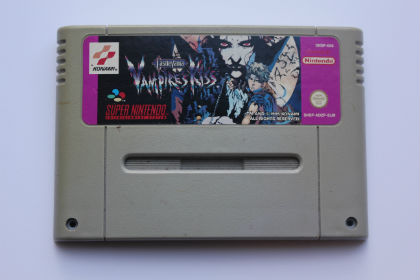
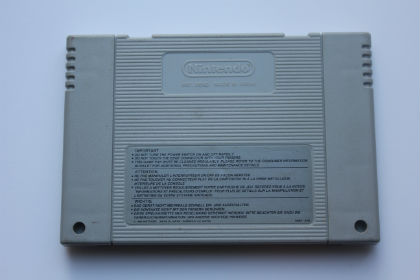
Checking the circuit board
- It will say Nintendo and give the year. This won't match the game year but it will match the year of the circuitboard. There is a great resource online at SNES Central.
- It will say "mask chip" and have a mask chip. Fakes use eProms, and although prototype carts also use eProms, this will not apply to the majority of games. Prototypes, like white label vinyl, are obviously prototypes on the outside as well. If you buy a regular cart you should not get a prototype game.
- Modifications, rewiring, desoldering or extra/missing components are dead give-aways of fake carts.
- Is there a battery pack where there shouldn't be?
- Are the pins themselves rectangular, or rounded-edged? One of the mods on the Nintendo Age forum says that SNES pins only have square edges, so that is something else to look for.
- Look for similarities differences in size, colour and manufacture. Is anything obviously extra or out of place?
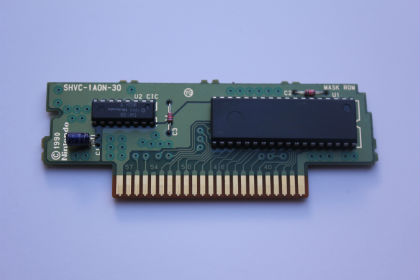
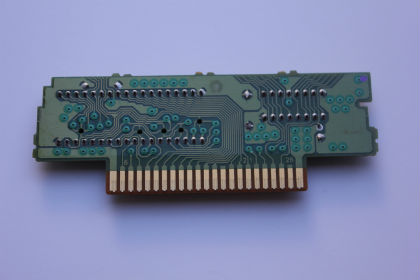
The boards below are pretty obviously fake. The left hand one is partly authentic - it has an authentic Nintendo board and another circuit board on top of that. Real games do not have this, and it means that someone has used the board from a cheap game for authenticity and then put another game (quite literally) on top of it. This kind of modification is a dead give-away. The right hand board is an awful fake because it is the wrong size, wrong colour, the pins look wrong and it has "RetroStage 2016" written in the top left.
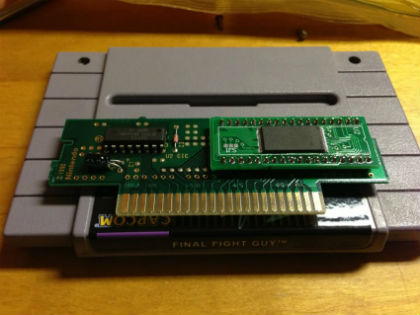
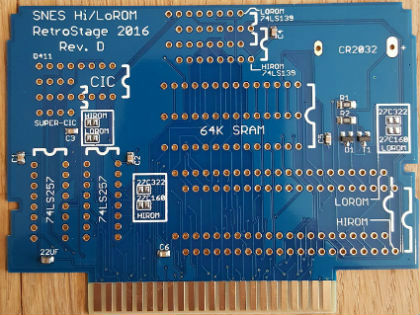
The below picture is an ePROM chip. If one of these is anywhere on your board then it is a fake board. Nintendo carts use Mask ROMs, not ePROMs. Mask ROMs are read only and their contents are programmed by the manufacturer. It is common to use ePROMs during the development stage, and then switch to Mask ROMs for the actual product manufacturing process. Mask ROMs are significantly cheaper so make sense for mass-production. ePROMs are programmable ROMs that retain their data when the power supply is switched off, and can be erased by UV light. The chips have a silicon window on their top side, through which the light is shone for the chip to be erased. This makes them very easy to spot - all ePROMs will have this erase windows. that are very easy to recognise because they have a transparent window on their top side. EPROMs are easily recognizable by the transparent fused quartz window in the top of the package, through which the silicon chip is visible, and which permits exposure to ultraviolet light during erasing. so it's fairly easy to take an old, authentic circuit board from a cheap game (say, Super Soccer for the SNES @ around £5) and then reprogram it with Vampire's Kiss for a much higher sale price (around £130). All you need is a new Vampire's Kiss sticker.
It becomes slightly confusing because ePROM chips were used by Nintendo in authentic carts, but only for prototypes. Regular sale games did not have them, only the prototypes did. More about ROMs here.
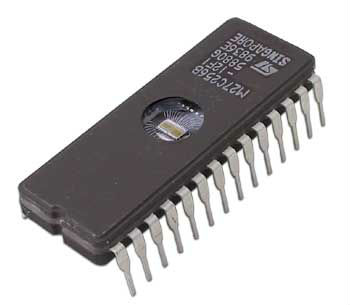
Tips for purchasing safely:
- Ask the seller for detailed pictures of the cart and board
- Check the game godes to see if they match - these are on the game, the box and the manual and should all be identical (e.g NES-SM-UKV, NES-SM-USA, NES-SM-UKV-2)
- Check the description fully for disclaimers or strange wording
- Ask for detailed pictures of the box and manual
- Check the seller's other items to see if any are fakes, repros or look dodgy
- Do everything you can, pre-sale, to verify the authenticity of the item and the integrity of the buyer
- Never transfer money to a bank account
- Never send cash
- Always go through PayPal or eBay or another service that offers BUYER PROTECTION
- As long as you are covered then buy ahead
Further reading
There are some excellent online resources for chcking boards, covert art and other details. If you believe a photograph to have been altered, you can also use some of the photo checking tools in the final link.
Submit a cart
If you have a cart you are unsure about, please contact us for assitance and we will help you verify your cart for no fee or charge. We only ask that you report the seller if it is proven that the item is fake.